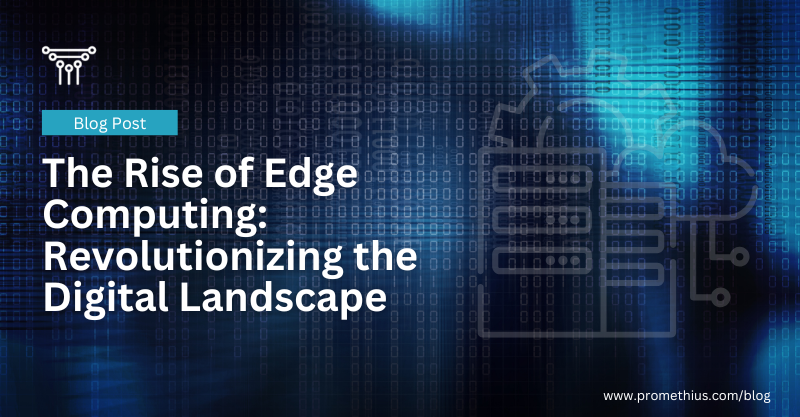The Rise of Edge Computing: Revolutionizing the Digital Landscape

In an era where digital transformation is at the forefront of technological advancement, edge computing has emerged as a game-changing paradigm. As the volume of data generated by internet-connected devices continues to skyrocket, the traditional model of centralized cloud computing is being pushed to its limits. Enter edge computing, a decentralized approach that brings computation and data storage closer to the location where it is needed. This shift is poised to revolutionize industries, enhance real-time processing, and address the growing demand for faster, more efficient data handling.
More...
What is Edge Computing?
Edge computing refers to the practice of processing data near the edge of the network, where the data is generated, rather than relying on a centralized data-processing warehouse. This approach minimizes the latency that occurs when data has to travel long distances to and from data centers. By bringing computation closer to the data source, edge computing ensures faster response times and improved performance.
At its core, edge computing involves a network of edge devices, edge servers, and edge gateways that work in concert to process and analyze data locally. These devices can range from simple sensors and smartphones to complex industrial machines and autonomous vehicles. The distributed nature of edge computing allows for more efficient use of bandwidth, reduced latency, and enhanced data security and privacy.

Benefits of Edge Computing
The adoption of edge computing offers a multitude of benefits across various sectors. Some of the key advantages include:
- Reduced Latency
One of the primary benefits of edge computing is its ability to significantly reduce latency. By processing data closer to the source, edge computing eliminates the delay associated with transmitting data to distant data centers. This is particularly critical for applications that require real-time responses, such as autonomous vehicles, industrial automation, and augmented reality. - Enhanced Data Security and Privacy
Edge computing can improve data security and privacy by keeping sensitive information closer to its source. Instead of sending raw data to central servers, edge devices can perform initial processing and filtering, ensuring that only relevant and anonymized data is transmitted. This reduces the risk of data breaches and unauthorized access, as the data remains within the local network. - Efficient Use of Bandwidth
As the number of connected devices grows, network bandwidth becomes a valuable resource. Edge computing helps optimize bandwidth usage by processing and filtering data locally. This reduces the amount of data that needs to be sent to centralized servers, alleviating network congestion and lowering transmission costs. - Scalability and Flexibility
The decentralized nature of edge computing makes it highly scalable and adaptable. With the ability to deploy edge nodes and devices as needed, organizations can easily expand their computing capabilities to meet growing demands. This flexibility is particularly beneficial for industries with dynamic and geographically dispersed operations.
Applications of Edge Computing
Edge computing is transforming a wide range of industries, enabling new use cases and enhancing existing ones. Some notable applications include:
- Autonomous Vehicles
Autonomous vehicles rely on real-time data processing to make split-second decisions. Edge computing enables these vehicles to process data from sensors, cameras, and other inputs locally, ensuring rapid response times and enhancing safety. - Industrial IoT
In the realm of industrial IoT, edge computing allows for real-time monitoring and control of manufacturing processes. By analyzing data from sensors and machinery on-site, companies can optimize production, reduce downtime, and perform predictive maintenance. - Healthcare
Edge computing is revolutionizing healthcare by enabling remote patient monitoring and telemedicine. Wearable devices and sensors can collect and analyze patient data in real-time, allowing healthcare providers to make timely and informed decisions. - Smart Cities
Smart cities leverage edge computing to manage and analyze data from various sources, such as traffic cameras, environmental sensors, and public transportation systems. This enables more efficient resource management, improved public safety, and enhanced quality of life for residents.
Challenges and Future Outlook
Despite its numerous advantages, edge computing also presents certain challenges. These include the complexity of managing distributed networks, ensuring interoperability between different devices and systems, and addressing potential security vulnerabilities. However, as technology continues to evolve, solutions to these challenges are being developed, paving the way for widespread adoption of edge computing.
In conclusion, edge computing is set to play a pivotal role in the future of digital transformation. By bringing computation and data storage closer to the source, it offers unparalleled benefits in terms of reduced latency, enhanced security, efficient bandwidth usage, and scalability. As industries continue to embrace this innovative approach, we can expect to see a new era of technological advancements and possibilities unfold.
